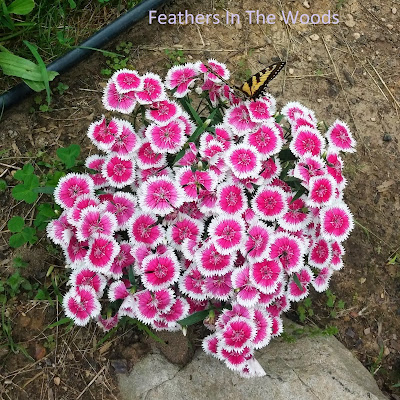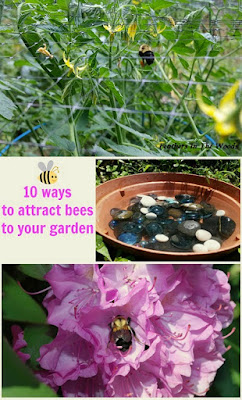While there isn't too much we can do on a large scale, there are several things we can do to attract these natural pollinators to our own gardens. The better pollination we have going on in the garden, the better chance we have of a great harvest.
Maybe I'm just lazy, but I have no plans of spending days in the garden hand pollinating my zucchinis! I need bees to do this for me....so I attract them to my garden.
How to attract bees to your garden
Short of becoming a beekeeper, what can we do to attract bees to the garden? It's actually quite simple and you might be surprised to find you're already doing some of these:
1.) Plant flowers amid your veggie plants.
Yes vegetable and fruit plants do flower themselves, but by adding flowers here and there around your garden you'll be sure to attract all types of pollinators to your garden. Marigolds are easy to start from seed.
2.) Plant for a constant supply of flowers:
Once they begin to bloom, plants like Marigolds will bloom continuously till a hard frost. Certain herbs that are used for flowers like Chamomile also bloom continuously. Other flowers bloom more sporadically. Still others like the Hosta only bloom once.
Choose early, late and mid-season blooms. Mix it up so that you always have a steady supply of flowers to attract bees to your garden.
3.) Colors, size, shape, texture & smell:
Blue, purple, white and yellow seem to be popular colors for most bees as do flat flowers like daisies. Think of the blooms this way: the easier it is for you to see the center of the flower, the easier it is for the bee to get to the center of the flower which is where the nectar and pollen are.
Also, different bees are attracted to different types of flowers. Bumblebees really like my Rhododendrons!
Contrary to popular belief it's not just the honeybees that do the pollinating. Different pollinators are active at different times of the year and actually prefer different types of blooms. I bet you didn't know that sweat bees really like strawberries, bumble bees are great at pollinating tomatoes and mason bees are quite fond of fruit tree blossoms.
Having a variety of blooms is a great way to attract a variety of pollinators. Bonus idea: Share the love and make a Save The Bees seed packet to share flower seeds with friends!
4.) Do not use pesticides:
Hang Japanese beetle bags, put out a shallow bowl of beer for slugs, hand picking tomato hornworms, etc etc....use natural methods to rid your garden of pests.
Insect killing sprays do not just kill the bugs you want it to, they're not that selective. If a spray is killing other bugs there's a good chance it's harming the bees too, so just skip it and go with less poisonous means of pest control.
5.) Give them a drink of water:
Bees need a drink of water too, especially on a hot day. Unfortunately most garden water sources like bird baths are too deep and they risk drowning. You can give bees a water source by putting small rocks into a bowl or shallow pan and adding water till its almost to the top of the rocks.
The rocks give them a safe place to land while they get a drink. The closer your bee water bowl is to flowering plants, the easier it will be for them to find.
6.) Bees like the sun:
Plant in a sunny location. Not only do bees like wide open sunny places, but most produce plants do also!
7.) Let some veggies bolt:
This goes for herbs too. Not only does this attract more pollinators but is absolutely necessary when saving seeds of certain plants.
8.) Plant wildflowers:
Natural wildflowers are becoming hard for bees to find these days. If you have an area near by where you can plant local varieties of wildflowers it will definitely help to attract local pollinators to your area. Native wildflowers attract native bees, while more exotic flowers tend to attract honeybees.
9.) Plant in clumps.
Not only does a huge clump of bright flowers act like a homing beacon to bees (they're not colorblind like some other critters) but if all your zucchini are in the same area, it just makes sense that the bees will hop from plant to plant collecting some nectar for themselves and pollinating the flowers for you!
10.) Plant perennials:
Most of the flowering perennials I have planted near my garden bloom earlier than the annuals I add every year. They are also more frost resistant so a late frost won't kill them off like it will with annuals.
Bonus.....There are about 4,000 species of native or wild bees in the continental U.S. 70% of them are ground nesters with only 30% nesting in dead trees and stems. Leaving some undisturbed ground area, and a small pile of dead twigs or old firewood can attract bees to nest in the area.
Why stop with just bees? You can plant your own butterfly garden too. Both the butterflies and bees would love it!Also, an area where native grasses or weeds are allowed to grow undisturbed year round can provide a nice habitat, nesting material and shelter for native bees. Now whether you want bees nesting near your garden and yard or not is up to you but I'm sure you'll agree that bees are an essential part of a healthy productive garden.
Having problems with different types of critters snacking on your garden too? Click here for my other posts on deterring garden pests!
~L
Want gardening and healthy living information sent right to your email weekly? Click right here to join my newsletter list and get new posts sent directly to you the day they're published!





I planted Greek Oregano in my garden. It self-seeds at an alarming rate! However, the bees and other flying insects do love it, so I always allow some to bloom. I also allow certain "weeds" to grow on the margins of the garden and they tend to attract a lot of pollinators.
ReplyDeleteI'll have to try oregano! I love herbs that self seed, even better if the bees like them too. Thanks for the tip!
DeleteLisa